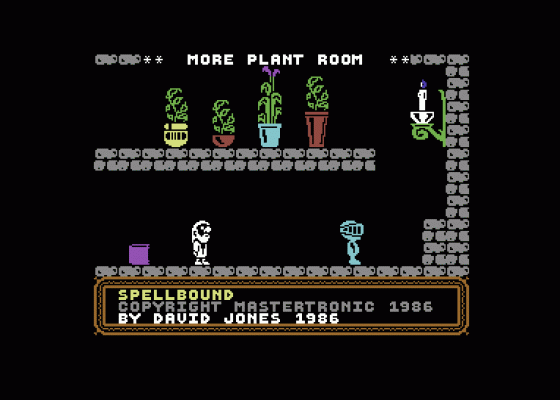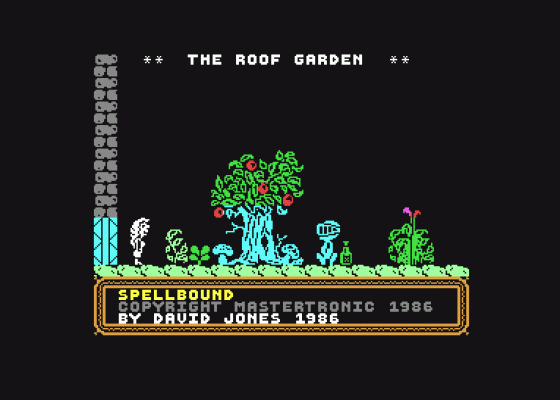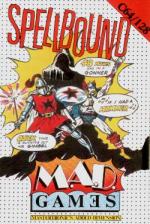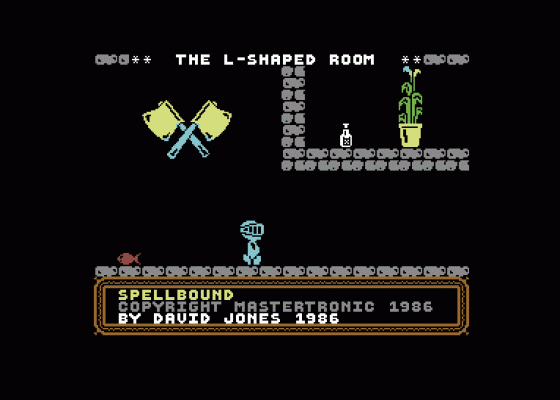
Zzap
 1st June 1986
1st June 1986
Categories: Review: Software
Publisher: Mastertronic Added Dimension
Machine: Commodore 64/128
Published in Zzap #14
Zzap Sizzler
Spellbound
Magic Knight, who previously starred in Finders Keepers, is back on the small screen with the release of Spellbound. This time the hero in a tin can is in a spot of bother with his pall and tutor, Gimbal the Wizard. Though adept at his craft, the poor magician is getting a little bit senile as old age creeps up on him, and as a result he made a slight mistake in casting a rice pudding improvement rune. Instead of having a something nice for afters, Gimbal and Manic Knight were zapped a million miles and years away to the mythical castle of Karn.
However, the tutor and scholar were not the only ones to be mystically teleported - a whole bunch of characters were ripped out of the space-time continuum and deposited within the castle. Since none of the other characters were really of the heroic type, Magic Knight decided that it was down to him to place all the different chaps and chapesses back into their respective times and homes.
There are eight other characters, including Gimbal, around the place and although they won't actively come to MK's aid - due to the lethargy induced when they were warped across mind staggering amounts of space/time - their help can be obtained by clever interaction. As a result the different persons within the Spellbound universe have to be looked after, and without the correct intervention it's all too possible to have one of them go and die on Magic Knight. The game ends if this happens.

Spellbound is a full implementation of an adventure within an arcade framework. The joystick is used to move MK between different locations whereas more complex actions are achieved by a person/computer interface known us Windovision. Pressing fire calls up the first menu, and allows access through it's various branches to a whole range of commands. The system is wholly dynamic, as the commands available to Magic Knight depend upon the objects within his inventory. A handy hand shaped pointer is used in conjunction with up and down to select a command and fire selects it. As the pointy-fingered paw passes various options, they highlight. The main commands available are those found in any type of text adventure: get, drop, give, take, examine, read and so on.
As any real person, Magic Knight has to look after his energy reserves. Using the examine command upon himself results in a fairly detailed resume of his current state of health. His physical state also affects how many objects he can carry - picking up an artifact when in an exhausted state causes the 'TOO HEAVY' message to appear. All the other characters have their own energy status and MK must also look after them. With their wits dimmed by teleportation, the poor souls don't even know when to sleep; it's up to MK to tell them.
The castle itself is a fairly interesting sort of place and is displayed as a series of flip screens, as our hero heroically bounds between them. The screens are labelled to make them easier to remember, and there're seven floors to castle Karn. To get between them a lift must be used and the commands needed to manipulate the lift pop into the window when appropriate. Neat, eh?

To complete the game, Gimbal must be rescued from the king of the castle who is holding him and then the senile sage will be able to bestow upon the player the happy ending he deserves.
JR
What a great game! The windowing system used is amazing and allows the player to do so much with the character. You open up one window and are presented with a heap of sub-menus, choosing one of these gives more sub menus and so on - so simple to use, but very effective indeed. I didn't like the music too much, it was a bit raucous, but the graphics are fine. The thing that's really fab 'n' brill is that it only costs three quid, and for a game with so much in it there's no excuse for you to miss it.
GP
Spellbound is the best Mastertronic release to date, and puts a majority of other, more expensive arcade adventures to shame. It's a doddle to get into and although it's difficult, it isn't frustrating. The Windovision system looks quite complex with so many commands and menus, but it is surprisingly easy to use and works extremely well. Despite adequate graphics and sound, Spellbound is very neat indeed and worth every penny of the ludicrously low asking price.
GL

Spellbound is very good indeed and it's something of a surprise to see a game of this quality appearing on a budget label. Most outstanding of all Spellbound's outstanding qualities is the game design. Windovision is about the best person / computer interface I've seen yet; it makes such prestigious releases as Shadowfire and Enigma Force look very clumsy indeed. Quite amusing considering the six pounds difference in price. Though the graphics aren't the best to be seen on the Commodore, they are fairly effective and do the job well. The theme tune is potentially annoying but that doesn't matter as long as you've got a volume control on your TV set. Next time you're set to fork out ten quid for game, take a look at Spellbound first, as you may find yourself saving an awful lot of money.
Verdict
Presentation 94%
The Windovision system allows easy input, and a wide variety of options are available.
Graphics 80%
Adequate and pleasant, though lacking in colour.

Sound 67%
Rob Hubbard assaults the ears once more, though this isn't a bad effort.
Hookability 93%
The arcade elements immediately hook any player...
Lastability 94%
... and the adventure bits provide the long term appeal.
Value For Money 99%
At this ridiculously low cost it's hard to justify not buying Spellbound.
Overall 94%
A superb release worthy of a £9.99 price tag, miss it at your peril.




